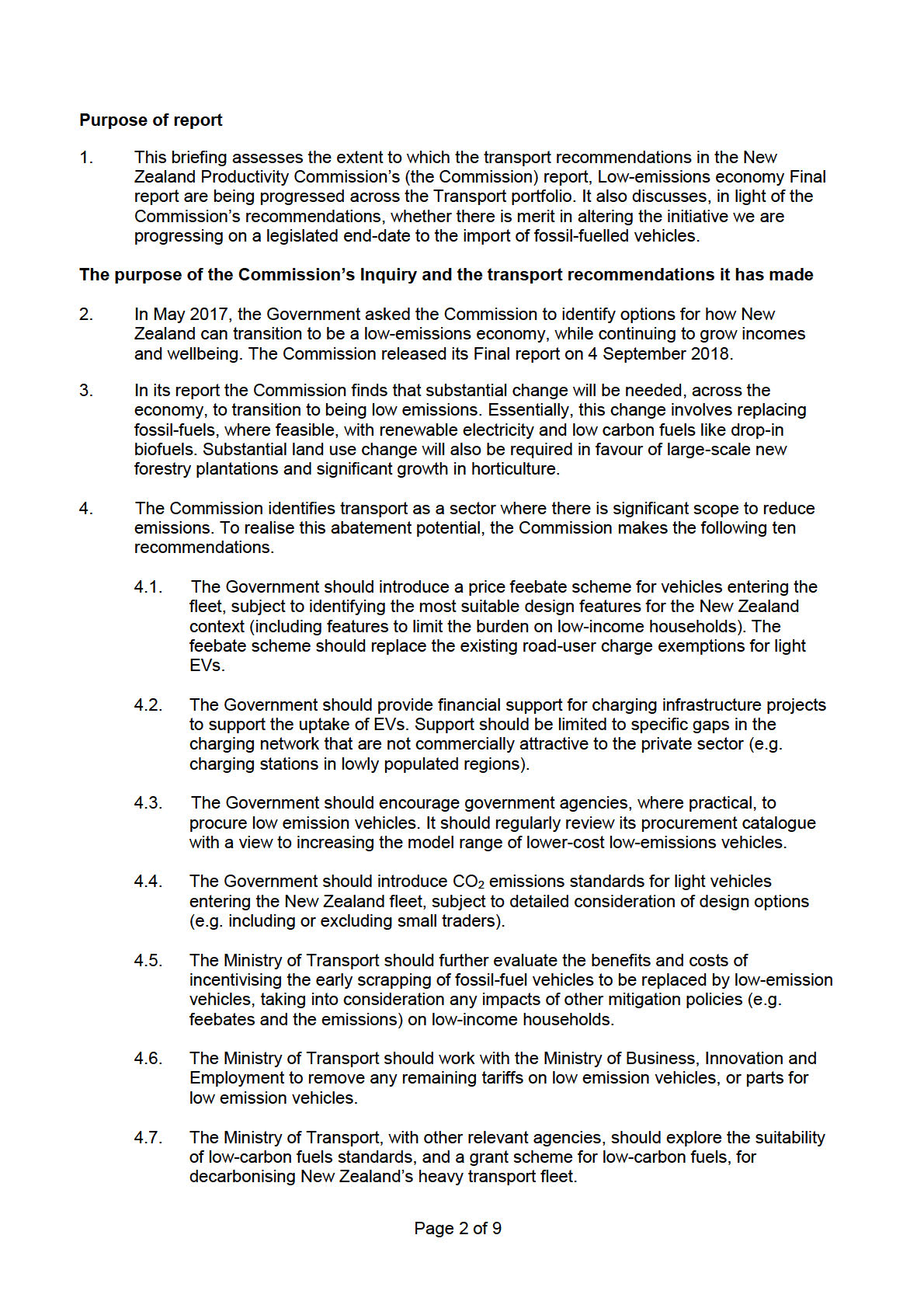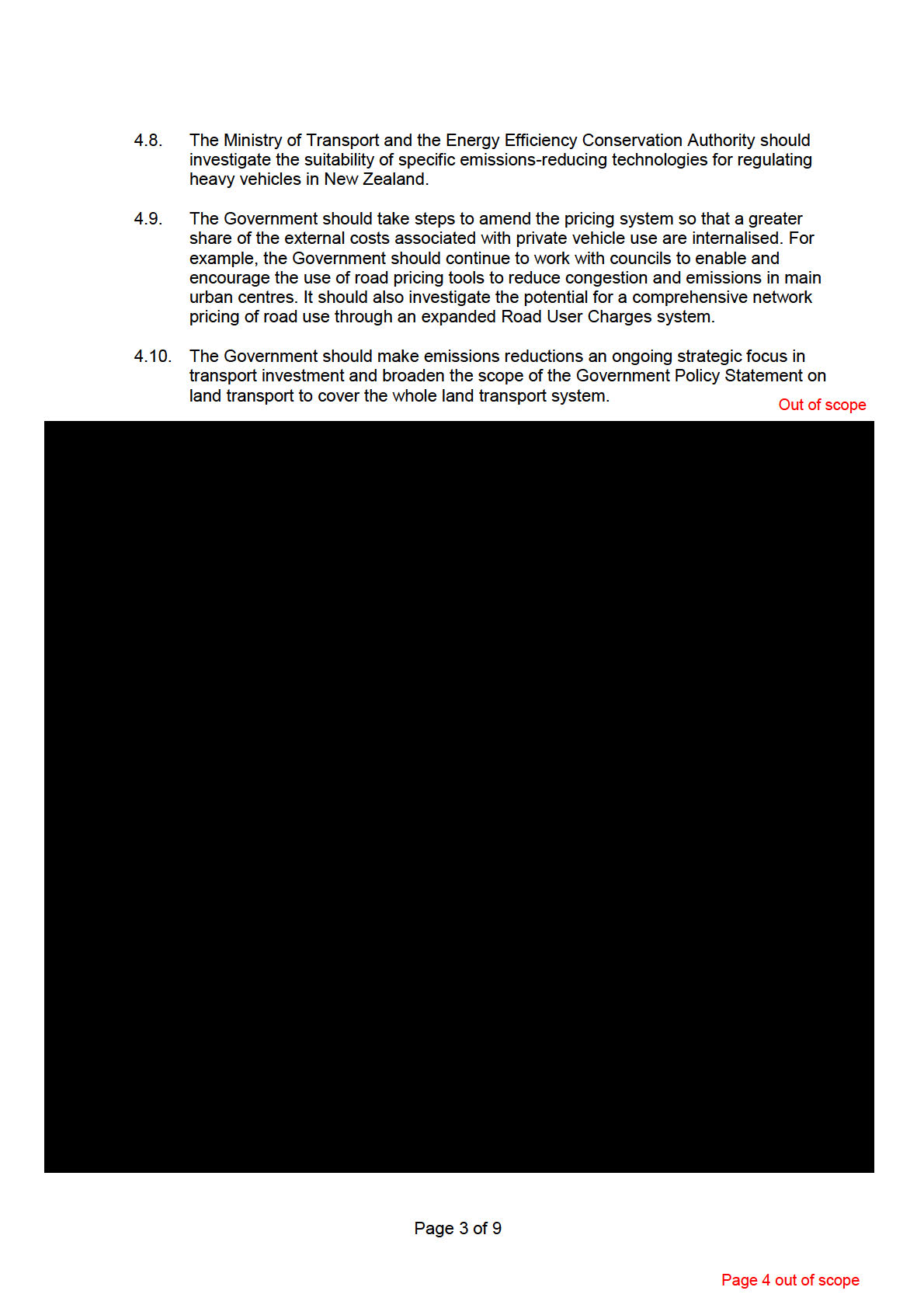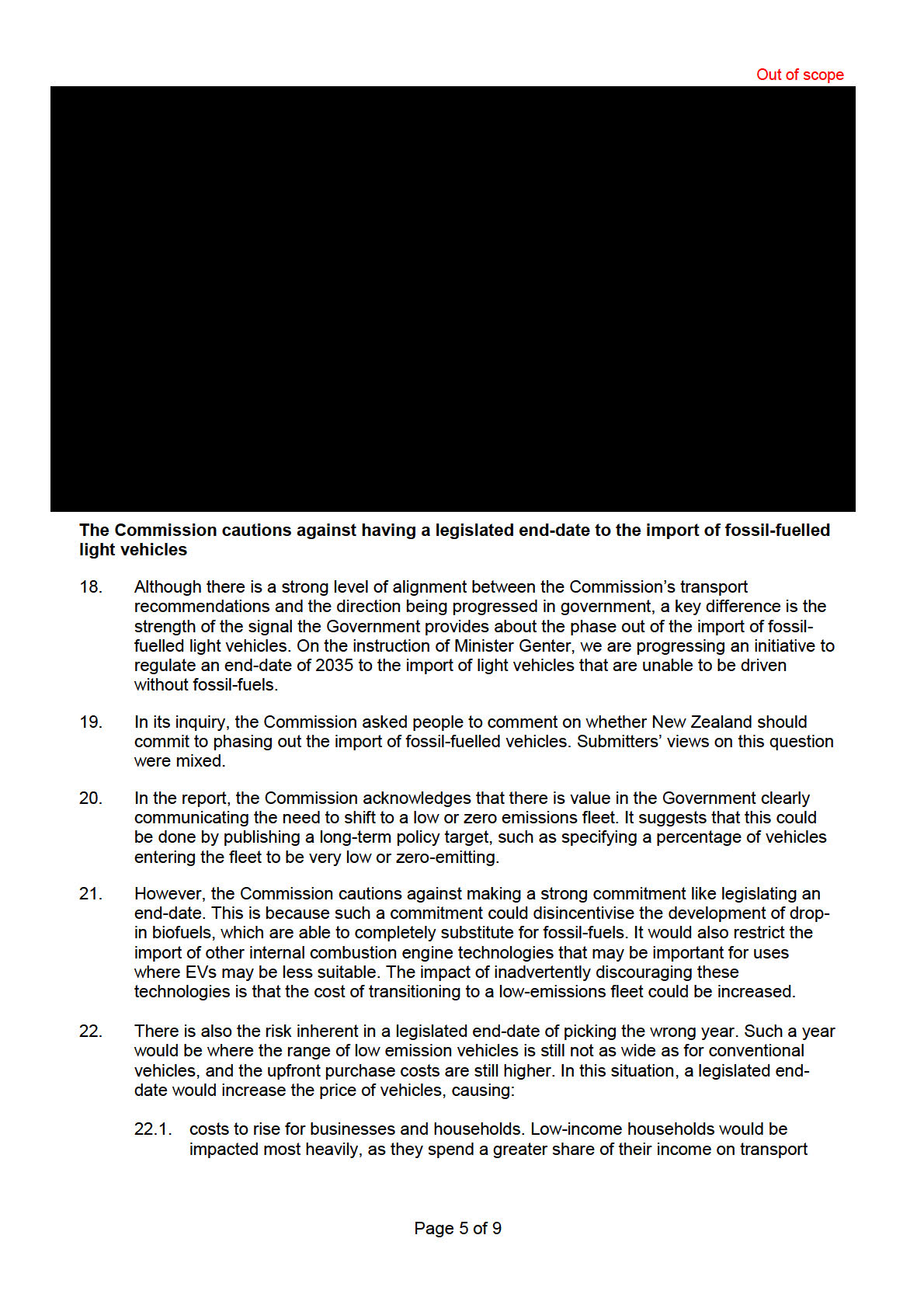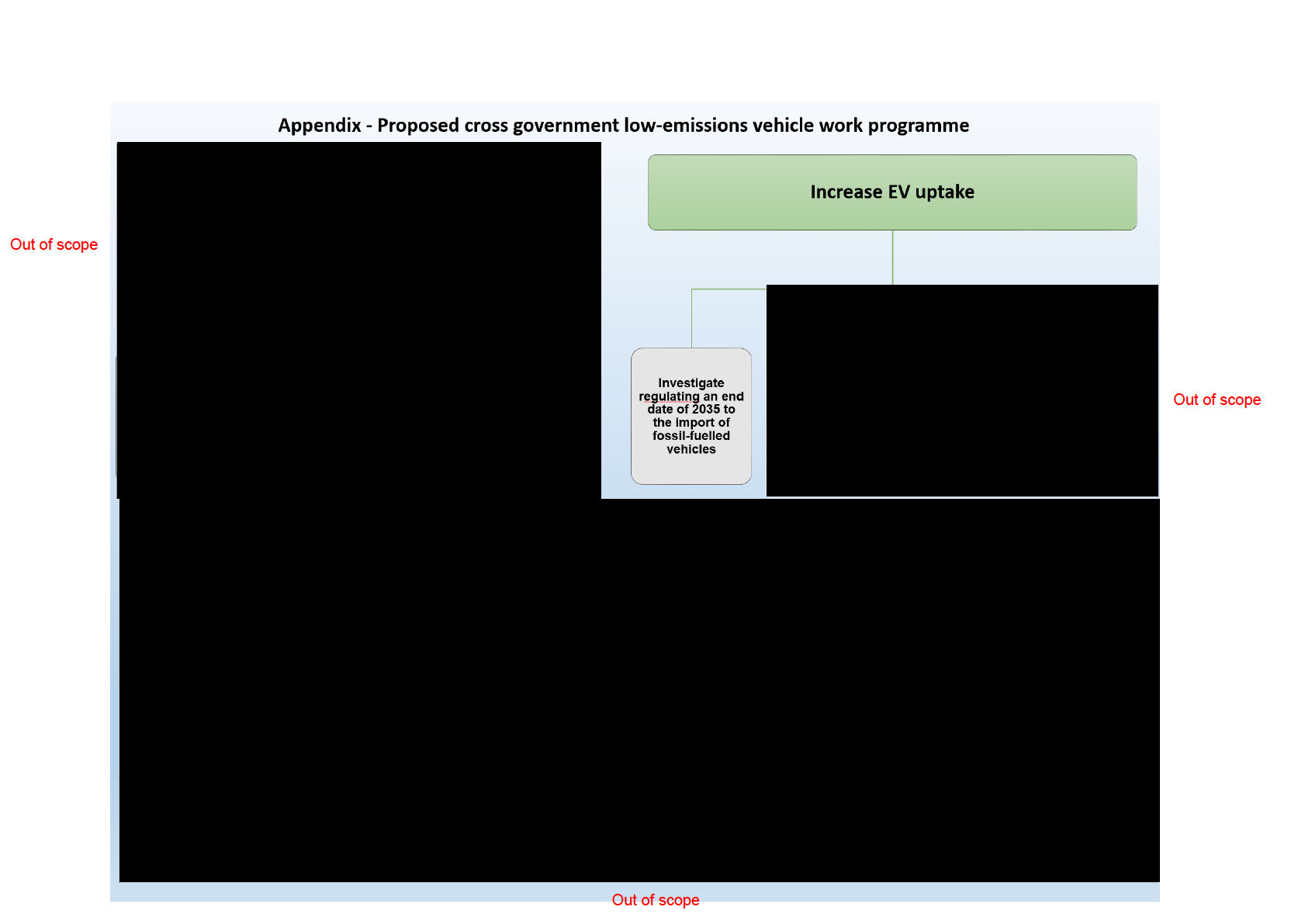
Document 4
BRIEFING
The Final Report from the New Zealand Productivity
Commission’s Low Emissions Economy Inquiry
Reason for this
On Tuesday 4 September 2018, the New Zealand Productivity Commission
briefing
released its report, Low-emissions economy Final report. This briefing
summarises the recommendations made about transport and assesses the
extent to which they are being progressed across the Transport portfolio. It
also considers whether any changes should be made to the initiative we are
progressing on a legislated end-date to the import of fossil-fuel ed vehicles
in light of the Commission’s advice.
Action required
Consider the attached briefing and advise us whether you would prefer to
progress a legislated end-date to the import of fossil-fuel ed vehicles, or a
non-binding target.
Deadline
17 September 2018.
Reason for
To enable us to action any changes to the work on the initiative to legislate
deadline
an end-date to the import of fossil-fuel ed vehicles.
Contact for telephone discussion (if required)
Telephone
First
Name
Position
contact
Glen-Marie Burns
Manager, Urban Development
and Environment
Principal Adviser, Urban
Development and Environment
Graduate Adviser, Urban
Development and Environment
MINISTER’S COMMENTS:
Withheld under section 9(2)(a)
Date:
11 September 2018
Briefing number: OC180698
Attention:
Hon James Shaw
Security level:
In confidence
CC: Hon Phil Twyford
Minister of Transport’s office actions
Noted
Seen
Approved
Needs change
Referred to
Withdrawn
Not seen by Minister
Overtaken by events



22.2. people to hold onto their existing fossil-fuel ed vehicles for longer. Where the vehicles
are high emit ing ones, the goal of reducing carbon emissions would be hampered.
As would the goal of improving road safety though the entry of safer vehicles into the
fleet.
23.
The Commission informed us that one of the new vehicle distributors is of the view that New
Zealand wil almost certainly face constraints in EV supply. This is because its parent
company wil be focusing its EV supply on gaining market share in China. Gaining a
significant share of the Chinese market is much more important than servicing a tiny market
like New Zealand.
There would be some advantages in having a non-binding target rather than a legislated end-
date
24.
These risks are real and warrant a consideration of whether it would be preferable to pursue
a non-binding target rather than a binding legislated one.
25.
The key advantage of a non-binding target is that it would clearly signal the long-term
direction of change while avoiding the above risks. It would also raise awareness about low
emission vehicles and give a degree of confidence to consumers and vehicle suppliers to opt
for them earlier. It would also increase industry and public acceptance of the need to
introduce initiatives like the vehicle fuel ef iciency standard and the feebate scheme.
26.
A non-binding target or legislated end-date could be supported by interim targets. If the
vehicle fuel efficiency standard were implemented, this would effectively set interim targets
for emissions reduction for vehicles entering the fleet. The first standard would have a
proposed fleet-wide emissions target of 105 grams CO2 per kilometre by 20251.
27.
The intention is that the emissions target in the vehicle fuel efficiency standard would be
reset to drive change. This would occur so that a second target would apply from 2025, and
a third from 2030 or earlier. The targets would become increasingly stronger to move the
market to a point where the vehicles entering the fleet have a low level of emissions by 2035.
The Ministry prefers a legislated end-date if the risks can be mitigated
28.
However, in the Ministry’s view a legislated end-date is preferable to a non-binding target as
long as its risks can be mitigated. The key disadvantage with a non-binding target is that it
would communicate intent, but it would provide less certainty of change.
29.
In contrast, a legislated end-date would enhance the credibility of New Zealand’s carbon
mitigation efforts internationally, and domestically it would maximise the momentum for
change by:
29.1. communicating the reality to New Zealanders that substantial reductions in transport
emissions are only possible if people shift to low emission vehicles, or low emission
modes. This is because the travel done in light vehicles accounts for 67 percent of
transport emissions
29.2. giving greater confidence to vehicle suppliers and consumers to opt for low emission
vehicles earlier rather than later. Achieving an earlier move is important to reduce the
1 As noted in the Appendix of the draft cabinet paper on the cross-government low-emissions vehicle work
programme
Page 6 of 9
number of conventional vehicles entering the fleet with their emissions locked-in for
around 20 years
29.3. giving greater confidence to energy suppliers to invest in EV charging infrastructure,
encouraging them to keep up with the level of EV uptake rather than waiting to
respond to excess demand.
30.
A legislated end-date would also remove the risk of New Zealand becoming a left-over
market for fossil-fuel vehicles. This risk is pronounced in New Zealand because around half
of the vehicles entering the fleet each year are used imports.
31.
The used sector differs from the new sector in that it tends not to be affiliated with any one
particular vehicle brand and its supply decisions are more driven by considerations of vehicle
cost. As well as vehicle cost, the new sector has a broader range of factors to consider in its
decisions. New vehicle distributors have ongoing vehicle brand reputations to maintain in the
market. They also have programmes of vehicle model updates and new model releases to
manage.
32.
The heightened cost motivator in the used sector makes New Zealand more vulnerable to
being a dumping ground for left-over, high emitting vehicles should there be a glut of used
fossil-fuel vehicles available on the global market. This could occur as countries
progressively move to low and zero emission vehicles in their fleets.
How could we mitigate the risks identified by the Commission?
33.
In our view, the risks identified by the Commission could be mitigated by:
33.1. reviewing the desirability of the legislated end-date prior to it coming into effect, for
example, in 2030. This review would examine whether there is any reason to delay
the end-date to avoid imposing significant costs on the economy. For example, if the
price of low emission light vehicles had not fallen significantly relative to conventional
vehicles, or if the range of low emissions vehicles available to consumers remains
limited
33.2. ensuring the wording of the legislated end-date does not discourage the development
and use of alternative fuels. For example, this could be done by making it clear that
vehicles that are viewed as being able to be driven without fossil fuels includes
alternative fuel vehicles, like hydrogen fuel-cell, and conventional vehicles where
drop-in biofuels are available in New Zealand.
Out of scope
Page 7 of 9
Out of scope
Page 8 of 9







